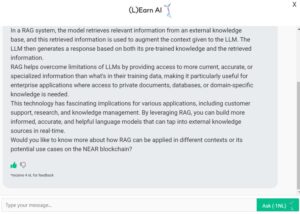What is an AI agent?
An AI agent is an autonomous software entity designed to perform tasks by perceiving its environment, processing information, and taking actions to achieve specific goals. An AI agent typically comprises three core components:
- Intelligence: The large language model (LLM) that drives the agent’s cognitive capabilities, enabling it to understand and generate human-like text. This component is usually guided by a system prompt that defines the agent’s goals and the constraints it must follow.
- Knowledge: The domain-specific expertise and data that the agent leverages to make informed decisions and take action. Agents utilize this knowledge base as context, drawing on past experiences and relevant data to guide their choices.
- Tools: A suite of specialized tools that extend the agent’s abilities, allowing it to efficiently handle a variety of tasks. These tools can include API calls, executable code, or other services that enable the agent to complete its assigned tasks.
What are the three core components of an AI agent?
What is RAG?
Retrieval-Augmented Generation (RAG) is an AI technique that enhances large language models (LLMs) by integrating relevant information from external knowledge bases. Through semantic similarity calculations, RAG retrieves document chunks from a vector database, where these documents are stored as vector representations. This process reduces the generation of factually incorrect content, significantly improving the reliability of LLM outputs.\cite{RAG}
A RAG system consists of two core components: the vector database and the retriever. The vector database holds document chunks in vector form, while the retriever calculates semantic similarity between these chunks and user queries. The more similar a chunk is to the query, the more relevant it is considered, and it is then included as context for the LLM. This setup allows RAG to dynamically update an LLM’s knowledge base without the need for retraining, effectively addressing knowledge gaps in the model’s training data.
The RAG pipeline operates by augmenting a user’s prompt with the most relevant retrieved text. The retriever fetches the necessary information from the vector database and injects it into the prompt, providing the LLM with additional context. This process not only enhances the accuracy and relevance of responses but also makes RAG a crucial technology in enabling AI agents to work with real-time data, making them more adaptable and effective in practical applications.
How does Retrieval-Augmented Generation (RAG) improve LLM responses?
What is Agent Memory?
AI agents, by default, are designed to remember only the current workflow, with their memory typically constrained by a maximum token limit. This means they can retain context temporarily within a session, but once the session ends or the token limit is reached, the context is lost. Achieving long-term memory across workflows—and sometimes even across different users or organizations—requires a more sophisticated approach. This involves explicitly committing important information to memory and retrieving it when needed.
Agent Memory with blockchain:
XTrace – A Secure AI Agent Knowledge & Memory Protocol for Collective Intelligence – will leverage blockchain as the permission and integrity layer for agent memory, ensuring that only the agent’s owner has access to stored knowledge. Blockchain is especially useful for this long persistent storage as XTrace provides commitment proof for the integrity of both the data layer and integrity of the retrieval process. The agent memory will be securely stored within XTrace’s privacy-preserving RAG framework, enabling privacy, portability and sharability. This approach provides several key use cases:
Stateful Decentralized Autonomous Agents:
- XTrace can act as a reliable data availability layer for autonomous agents operating within Trusted Execution Environments (TEEs). Even if a TEE instance goes offline or if users want to transfer knowledge acquired by the agents, they can seamlessly spawn new agents with the stored network, ensuring continuity and operational resilience.
XTrace Agent Collaborative Network:
- XTrace enables AI agents to access and inherit knowledge from other agents within the network, fostering seamless collaboration and eliminating redundant processing. This shared memory system allows agents to collectively improve decision-making and problem-solving capabilities without compromising data ownership or privacy.
XTrace Agent Sandbox Test:
- XTrace provides a secure sandbox environment for AI agent developers to safely test and deploy their agents. This sandbox acts as a honeypot to detect and mitigate prompt injection attacks before agents are deployed in real-world applications. Users can define AI guardrails within XTrace, such as restricting agents from mentioning competitor names, discussing political topics, or leaking sensitive key phrases. These guardrails can be enforced through smart contracts, allowing external parties to challenge the agents with potentially malicious prompts. If a prompt successfully bypasses the defined safeguards, the smart contract can trigger a bounty release, incentivizing adversarial testing. Unlike conventional approaches, XTrace agents retain memory of past attack attempts, enabling them to autonomously learn and adapt to new threats over time. Following the sandbox testing phase, agents carry forward a comprehensive memory of detected malicious prompts, enhancing their resilience against similar attacks in future deployments.
How to create a Personalized AI agent?
To create an AI agent with XTrace, there are three main steps to follow:
- Define the Purpose: Determine the specific tasks and goals the agent will accomplish.
- Choose the AI Model: Select a suitable LLM or other machine learning models that align with the agent’s requirements.
- Gather and Structure Knowledge: Collect domain-specific data and organize it in a way that the agent can efficiently use.
- Develop Tools and Integrations: Incorporate APIs, databases, or other services that the agent may need to interact with.
How to create a Private Personalized AI agent with XTrace?
XTrace can serve as the data connection layer between the user and the AI agents. Users will be able to securely share data from various apps into the system to create an AI agent that is aware of the user’s system. By leveraging XTrace’s encrypted storage and access control mechanisms, AI agents can be personalized without compromising user privacy. Key features include:
- Seamless Data Integration: Aggregating data from multiple sources securely.
- Granular Access Control: Ensuring only authorized AI agents can access specific data.
- Privacy-Preserving Computation: Enabling AI agents to learn from user data without exposing it.
- Automated Insights: Leveraging AI to provide personalized recommendations based on securely stored data.
- User Ownership: Empowering users with full control over their data and how it is used.
How do we use XTrace private RAG for (L)Earn AI🕺?
- We send learning materials in LLM friendly format to LNC RAG at XTrace

- Once (L)Earn AI🕺 gets the question, first it talks to private RAG and retrieve relevant information

- The LLM hosted at NEAR AI infrastructure generates a response based on both its pre-trained knowledge and the retrieved information!

- Learners are encouraged to provide feedback and get 4nLEARNs to improve (L)Earn AI🕺 to work better for NEAR community!
Updated: February 24, 2025





Top comment
The XTrace can serve as the data connection layer, facilitating communication between users and AI agents.
I'm excited to see how XTrace private RAG is being utilized to enhance the (L)Earn AI experience! The idea of sending learning materials in an LLM-friendly format to the RAG and then retrieving relevant information to inform AI responses is genius. I'm curious to know more about the type of feedback learners are encouraged to provide and how that feedback is used to improve the AI. Is there a way to track the progress and effectiveness of the 4nLEARNs system? Additionally, how does the NEAR community plan to expand the capabilities of (L)Earn AI in the future?
This explanation of how XTrace private RAG is used for (L)Earn AI is fascinating! I love how the process involves a seamless collaboration between the LNC RAG, private RAG, and the LLM hosted on NEAR AI infrastructure. The fact that learners can provide feedback and earn 4nLEARNs to improve the AI is a great incentive to encourage community engagement. I'm curious to know more about how the feedback mechanism works and how it impacts the AI's performance over time. Can anyone share more insights on this?
This concept of Agent Memory with blockchain is truly innovative! I'm impressed by how XTrace addresses the integrity and privacy concerns of AI agent knowledge and memory. The use of blockchain as a permission and integrity layer ensures that only authorized parties have access to the stored knowledge, which is a major leap forward in terms of security. I'm particularly intrigued by the XTrace Agent Collaborative Network, which enables seamless collaboration among agents without compromising data ownership or privacy. This has huge implications for collective intelligence and decision-making capabilities. My only question is: how does XTrace plan to balance the need for autonomy in AI agents with the need for human oversight and regulation? Are there any plans to integrate human-in-the-loop mechanisms to ensure accountability and transparency in agent decision-making?
i missig Near ko finsih
Good project
I found this outline for creating a personalized AI agent with XTrace to be a great starting point, but I think there's an important consideration missing – human oversight and accountability. As AI agents become more autonomous, it's crucial to ensure that their goals and tasks align with human values and ethics. I'd love to see an additional step focused on implementing safeguards and regular evaluation processes to prevent bias and unintended consequences. How do others think we can effectively balance AI autonomy with human responsibility?
This concept of creating a private personalized AI agent with XTrace is a game-changer! By leveraging XTrace's secure data integration and access control mechanisms, users can finally have an AI system that truly understands their needs without compromising their privacy. I'm particularly excited about the granular access control feature, which ensures that only authorized agents can access specific data. However, I do wonder how the automated insights feature will handle ambiguous or contradictory data from different sources. Will there be a way for users to correct or refine the AI's recommendations? Overall, this technology has tremendous potential for empowering users and preserving their autonomy.
This definition of an AI agent highlights the intricate dance between intelligence, knowledge, and tools. What strikes me is how closely these components mirror the human decision-making process. Just as we rely on our cognitive abilities, personal experiences, and external resources to make informed choices, AI agents do the same. But what about the potential pitfalls of relying on domain-specific knowledge and system prompts? How might these influences shape an agent's goals and decision-making, and what are the implications for accountability? Looking forward to exploring these questions further in the realm of AI development.
This article provides a great starting point for creating a personalized AI agent with XTrace. I especially appreciate the emphasis on defining the purpose and gathering structured knowledge, as these steps seem crucial in ensuring the agent's effectiveness. However, I'm curious to know more about the importance of choosing the right AI model. Are there any specific considerations or trade-offs to keep in mind when selecting an LLM or other machine learning models? Additionally, can the author provide more insights on how to develop effective tools and integrations that seamlessly interact with the agent?
This concept of creating a private personalized AI agent with XTrace is fascinating! The emphasis on user privacy and control is particularly intriguing, especially in an era where data exploitation is rampant. I'm curious to know more about the technical implementation of the privacy-preserving computation feature – how does it ensure that AI agents learn from user data without actually accessing it? Additionally, I'd love to see examples of how the automated insights feature can be applied in real-life scenarios, such as personalized health advice or tailored financial planning. The potential for XTrace to revolutionize the way we interact with AI is vast, and I'm excited to see it in action!
This concept of using blockchain-based XTrace protocol for secure AI agent memory and knowledge sharing is fascinating! I'm particularly intrigued by the potential for decentralized autonomous agents to inherit knowledge from other agents, enabling collective intelligence and improved decision-making. The sandbox test environment also sounds like a game-changer for detecting and mitigating prompt injection attacks. I do wonder, however, about the scalability of this approach as the number of agents and interactions grows. How will the blockchain-based integrity layer handle the increased load, and what measures will be taken to prevent potential bottlenecks? Looking forward to seeing further developments on this promising technology!